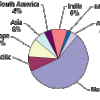Strategic advice to leverage new technologies
Technology is at the heart of nearly every enterprise, enabling new business models and strategies, and serving as the catalyst to industry convergence. Leveraging the right technology can improve business outcomes, providing intelligence and insights that help you make more informed and accurate decisions. From finding patterns in data through data science, to curating relevant insights with data analytics, to the predictive abilities and innumerable applications of AI, to solving challenging business problems with ML, NLP, and knowledge graphs, technology has brought decision-making to a more intelligent level. Keep pace with the technology trends, opportunities, applications, and real-world use cases that will move your organization closer to its transformation and business goals.
Recently Published
"Citrus dreamsicle cake... HEAVEN!!! Why did I only give them four stars as opposed to five?!?!??! the cake was too small. :( sad face... yup.. def. sad face there. My previous cake for the same price was 3 layers and the citrus one was only 2 layers. I should have specified. But it was AWESOMELY! good cake."
Sorry for Whose "Inconvenience"?
APOLOGIZE, v.i. To lay the foundation for a future offence.
-- Ambrose Bierce, The Devil's Dictionary
Ah, another day, another data breach; another insincere apology most probably written by a corporate lawyer.
Google's introduction of the Chromebook has serious implications for cloud computing and IT -- and threatens to shake up enterprise computing. Google is hoping that companies will find Chromebook's reduced maintenance and lower cost of ownership too good to resist. But Google does not expect companies to embrace Chromebook overnight.
In February/March 2011, Cutter Consortium conducted a survey asking 60 end-user organizations various questions about the adoption and use of predictive analytics. The goal was to uncover corporate adoption trends and examine application development issues to discern how organizations are applying predictive analytics technology and practices to structured data analysis.
This webinar presents an overall enterprise architecture that incorporates the many different perspectives of the cloud, addresses the range of issues, and describes a framework to govern what can be moved to the cloud, what should not be moved, what IT should do proactively, what the business can do on its own, and what it must coordinate with IT.
In my last Advisor, I discussed the characteristics that you should expect from an enterprise application architecture (see "Are You Ready for New Media?" 27 April 2011). This week, I'll explore two fundamental concepts of the application architecture: layers and tiers.













